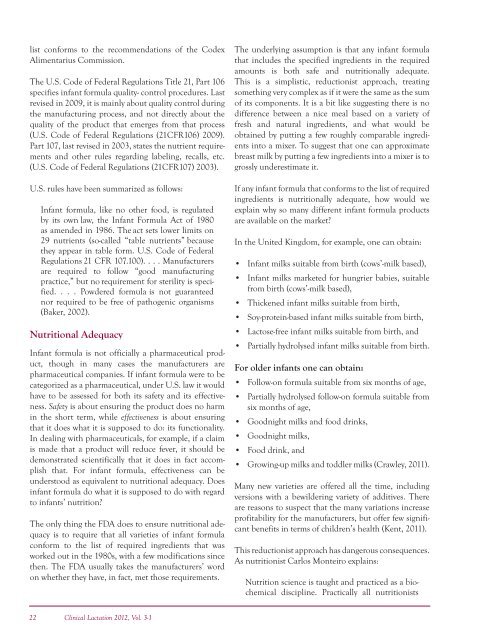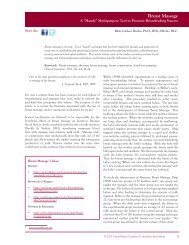Official Journal of the United States Lactation ... - Clinical Lactation
Official Journal of the United States Lactation ... - Clinical Lactation
Official Journal of the United States Lactation ... - Clinical Lactation
You also want an ePaper? Increase the reach of your titles
YUMPU automatically turns print PDFs into web optimized ePapers that Google loves.
list conforms to <strong>the</strong> recommendations <strong>of</strong> <strong>the</strong> Codex<br />
Alimentarius Commission.<br />
The U.S. Code <strong>of</strong> Federal Regulations Title 21, Part 106<br />
specifies infant formula quality- control procedures. Last<br />
revised in 2009, it is mainly about quality control during<br />
<strong>the</strong> manufacturing process, and not directly about <strong>the</strong><br />
quality <strong>of</strong> <strong>the</strong> product that emerges from that process<br />
(U.S. Code <strong>of</strong> Federal Regulations (21CFR106) 2009).<br />
Part 107, last revised in 2003, states <strong>the</strong> nutrient requirements<br />
and o<strong>the</strong>r rules regarding labeling, recalls, etc.<br />
(U.S. Code <strong>of</strong> Federal Regulations (21CFR107) 2003).<br />
U.S. rules have been summarized as follows:<br />
Infant formula, like no o<strong>the</strong>r food, is regulated<br />
by its own law, <strong>the</strong> Infant Formula Act <strong>of</strong> 1980<br />
as amended in 1986. The act sets lower limits on<br />
29 nutrients (so-called “table nutrients” because<br />
<strong>the</strong>y appear in table form. U.S. Code <strong>of</strong> Federal<br />
Regulations 21 CFR 107.100). . . . Manufacturers<br />
are required to follow “good manufacturing<br />
practice,” but no requirement for sterility is specified.<br />
. . . Powdered formula is not guaranteed<br />
nor required to be free <strong>of</strong> pathogenic organisms<br />
(Baker, 2002).<br />
Nutritional Adequacy<br />
Infant formula is not <strong>of</strong>ficially a pharmaceutical product,<br />
though in many cases <strong>the</strong> manufacturers are<br />
pharmaceutical companies. If infant formula were to be<br />
categorized as a pharmaceutical, under U.S. law it would<br />
have to be assessed for both its safety and its effectiveness.<br />
Safety is about ensuring <strong>the</strong> product does no harm<br />
in <strong>the</strong> short term, while effectiveness is about ensuring<br />
that it does what it is supposed to do: its functionality.<br />
In dealing with pharmaceuticals, for example, if a claim<br />
is made that a product will reduce fever, it should be<br />
demonstrated scientifically that it does in fact accomplish<br />
that. For infant formula, effectiveness can be<br />
understood as equivalent to nutritional adequacy. Does<br />
infant formula do what it is supposed to do with regard<br />
to infants’ nutrition<br />
The only thing <strong>the</strong> FDA does to ensure nutritional adequacy<br />
is to require that all varieties <strong>of</strong> infant formula<br />
conform to <strong>the</strong> list <strong>of</strong> required ingredients that was<br />
worked out in <strong>the</strong> 1980s, with a few modifications since<br />
<strong>the</strong>n. The FDA usually takes <strong>the</strong> manufacturers’ word<br />
on whe<strong>the</strong>r <strong>the</strong>y have, in fact, met those requirements.<br />
The underlying assumption is that any infant formula<br />
that includes <strong>the</strong> specified ingredients in <strong>the</strong> required<br />
amounts is both safe and nutritionally adequate.<br />
This is a simplistic, reductionist approach, treating<br />
something very complex as if it were <strong>the</strong> same as <strong>the</strong> sum<br />
<strong>of</strong> its components. It is a bit like suggesting <strong>the</strong>re is no<br />
difference between a nice meal based on a variety <strong>of</strong><br />
fresh and natural ingredients, and what would be<br />
obtained by putting a few roughly comparable ingredients<br />
into a mixer. To suggest that one can approximate<br />
breast milk by putting a few ingredients into a mixer is to<br />
grossly underestimate it.<br />
If any infant formula that conforms to <strong>the</strong> list <strong>of</strong> required<br />
ingredients is nutritionally adequate, how would we<br />
explain why so many different infant formula products<br />
are available on <strong>the</strong> market<br />
In <strong>the</strong> <strong>United</strong> Kingdom, for example, one can obtain:<br />
••<br />
Infant milks suitable from birth (cows’-milk based),<br />
••<br />
Infant milks marketed for hungrier babies, suitable<br />
from birth (cows’-milk based),<br />
••<br />
Thickened infant milks suitable from birth,<br />
••<br />
Soy-protein-based infant milks suitable from birth,<br />
••<br />
Lactose-free infant milks suitable from birth, and<br />
••<br />
Partially hydrolysed infant milks suitable from birth.<br />
For older infants one can obtain:<br />
••<br />
Follow-on formula suitable from six months <strong>of</strong> age,<br />
••<br />
Partially hydrolysed follow-on formula suitable from<br />
six months <strong>of</strong> age,<br />
••<br />
Goodnight milks and food drinks,<br />
••<br />
Goodnight milks,<br />
••<br />
Food drink, and<br />
••<br />
Growing-up milks and toddler milks (Crawley, 2011).<br />
Many new varieties are <strong>of</strong>fered all <strong>the</strong> time, including<br />
versions with a bewildering variety <strong>of</strong> additives. There<br />
are reasons to suspect that <strong>the</strong> many variations increase<br />
pr<strong>of</strong>itability for <strong>the</strong> manufacturers, but <strong>of</strong>fer few significant<br />
benefits in terms <strong>of</strong> children’s health (Kent, 2011).<br />
This reductionist approach has dangerous consequences.<br />
As nutritionist Carlos Monteiro explains:<br />
Nutrition science is taught and practiced as a biochemical<br />
discipline. Practically all nutritionists<br />
22 <strong>Clinical</strong> <strong>Lactation</strong> 2012, Vol. 3-1




